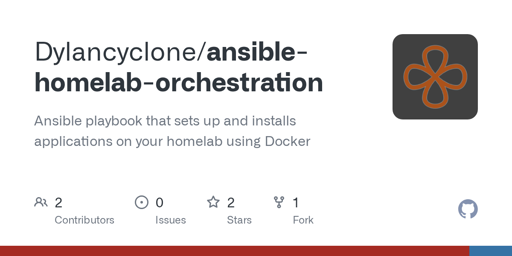Hi! I wanted to share a project I’ve been working on that lets you set up a huge variety of applications really quickly and painlessly. For example, instead of setting up and configuring a large docker compose for a complicated application like Immich, this playbook lets you simply write:
immich_enabled: true
And it will orchestrate all the containers, networks, directories, etc for you with reasonable defaults. All of which can be overwritten, for example to enable extra features like hardware acceleration:
immich_hardware_acceleration: "-cuda"
Or to automatically get a letsencrypt cert and expose the application on a subdomain to the outside world:
immich_available_externally: true
Included in the playbook is a ton of complicated applications, like Paperless, Meelo, TTRSS, Dawarich, as well as common self-hosted apps like Jellyfin, Home Assistant, Syncthing, Navidrome, Grafana, and a whole lot more (totaling 116 right now!).
It also comes with scripts and tests to help add your own applications (ansible roles) and ensure they work properly
I’ve been using this project myself for awhile, including to assist with moving from one homelab computer to another (point the playbook to the new address, run it to install everything, and restore a backup from the previous computer for data), and I hope it can help someone else build up their homelab without sinking too much time into setting things up
Here’s the repository: https://github.com/Dylancyclone/ansible-homelab-orchestration
And the documentation (that I’m really proud of :D): https://dylancyclone.github.io/ansible-homelab-orchestration/
As someone who’s done cloud infrastructure professionally, this is the right way to make a project for setting up self-hosted applications. Not writing a bunch of bash scripts and putting them behind some web UI. We have well established infrastructure/config-as-code systems that are the gold standard which runs most clouds out there. Ansible is one of them. That’s the right tool for this job and a ton of professionals understand it and therefore can easily contribute improvements for the ones who don’t to use. I’m unfortunatrly invested in SaltStack but I wouldn’t feel worried to deploy a (well reviewed) project built on Ansible. Then slap a web UI on it if you like but that should be another project that hooks uses this one.
You may also want to look into MASH: https://github.com/mother-of-all-self-hosting/mash-playbook
I need to learn Ansible. Seems like an easy way to orchestrate server ‘stuff’
This project was basically how I learned Ansible haha. It is incredibly powerful and this really only scratches the surface
For large server estates it makes things a breeze to manage, that and semaphore.
Great job, thanks for sharing.
I used a similar project called Ansible NAS a while back and it’s been working beautifully. I had a problem and had to reinstall the OS on my NAS at some point and this made it a breeze. That project requires Ubuntu and I prefer Debian so I may try this out next time.
This is definitely inspired by ansible-nas! I’d also used it for awhile, and made my own fork to add/fix things since the project has gone a little dormant. I started making so many changes though that I started fresh and it turned it into a whole project of it’s own. You can see a list of differences here: https://dylancyclone.github.io/ansible-homelab-orchestration/guides/introduction/
Or copy-pasted:
- Does not require root to run
- Runs containers with minimum privileges (no root unless absolutely necessary)
- Allow any application to have it’s name, image name and version overridden (in case of version pinning or running forks)
- Does not modify existing system settings/configuration
- Separates DNS access from external access (for example, access
portainer.example.comon local network without exposing it to the internet) - Notifies the user of breaking changes in an application’s ansible role before updating them
- Everything is optional, doesn’t install anything except what’s configured by the user
- Cleans up networks and containers more gracefully after disabling applications, and ensure nothing is left dangling
- Supports more OSs than just Ubuntu
- Includes suite of tests to ensure clean code and functionality
- All created containers and networks are removed when stopping applications
- Ensures all applications have consistent variable names and settings
- Ensures all applications properly implement DNS and external access settings
- Ensures no port conflicts between applications
- etc
Awesome improvements! Really nice work. I’ll definitely be switching at some point when I have a reason to mess with it. Thanks for all the extra work you’ve done to improve the fork and gift the project to the commons.
@Dylancyclone looks fantastic, great work!
This is probably my lack of Ansible experience here but how are multiple servers setup? Can I specify a different server per application?
You can use host_vars to set different variables per host. You’d still run the same playbook against both hosts, but each has different services activated.
- Make the folder host_vars in the repo root
- Make subfolders for every host with their hostname
- Enable services you want by writing the variables into a yaml file for your host (any file name as long as it ends with .yml
- Write an Ansible inventory for your hosts
- Run the playbook with your inventory
Slightly fancier would be using group_vars instead, you can add a host to multiple groups. Then deploying the same services on a new hosts would simply be adding it to the group
TL;DR: yes
Just from a quick view of the repo, the simplest way to do it would be to look at the
playbook.ymland copy all roles you want for a host into a new playbook, saymyhost.yaml. Copy not only the roles but all the other keywords as well. Then you go to the inventory and add your hosts where you to execute the playbook against. Then you change thehostskey value in the playbook you made fromallto the hosts you added to the inventory.That is, add your hosts to the inventory, create playbooks for for them and run. That is the easiest. Read up on how to do groups and organizing your inventory to improve it from there.








